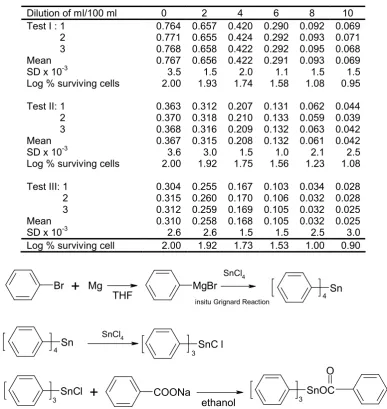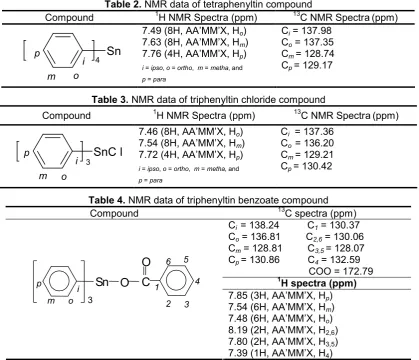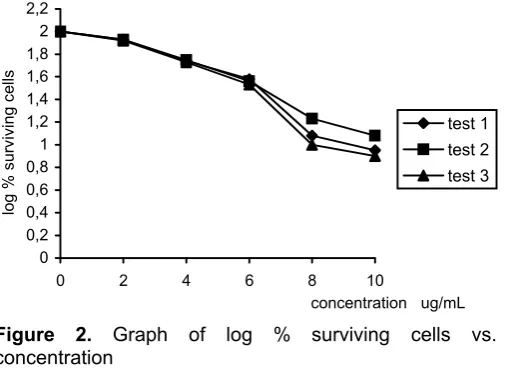* Corresponding author. Tel/Fax : +62-361-701954 ext. 259
SYNTHESIS, IDENTIFICATION AND IN VITRO ANTITUMOUR PRESCREENING TEST OF
TRIPHENYLTIN BENZOATE TOWARDS
A HUMAN CERVICAL CARCINOMA CELL LINE, HeLa
Ida Bagus Putra Manuaba
Chemistry Department Faculty of Mathematics and Science, Udayana University, Kampus Jimbaran Bali
Received 25 April 2008; Accepted 16 September 2008
ABSTRACT
In this study, triphenyltin benzoate was synthesized first, and followed by antitumor prescreening test of the compound towards a human cervical carcinoma cell line, HeLa. Three reaction steps were employed to obtain the compound needed, i.e. 1) synthesizing of tetraphenyltin compound via insitu phenilmagnesiumbromide Grignard reaction to tin(IV)chloride, 2) synthesizing triphenyltin chloride via redistribution reaction of tetraphenyltin to tin(IV) chloride without any solvent, the reaction completed depends on the temperature, in this case a good results was achieved at temperature 220 °C for 6 h, 3) finally, triphenyltin benzoate was produced through a methathetical reaction of triphenyltin chloride to an excess of sodium benzoate in ethanol. In vitro prescreening antitumour activity of the compound towards a human cervical tumour cell line, HeLa was carried out following an enzyme linked immunosorbent assays (ELISA). By this method, the test ended with good promising results. This indicates by the IC50 of 170 nM which is compared well to cisplatinum with IC50 950 nM.
Keywords: redistribution reaction, methathetical reaction, cell line, in vitro, antitumour. INTRODUCTION
Research on the use of compounds for inhibiting tumour cell lines are limited by knowledge of chemical properties, biological target, and negative impact of the compounds towards normal cells. So far, reaction mechanism of how the compounds tested could inhibit the tumour cells has not clearly been understood. However, the main target of the compounds tested could be DNA, whether they inhibit the DNA synthesis or stopped proliferation of tumour cell [1,2].
As well as tin based compounds, their mechanism for inhibiting tumour cell lines could be in a similar way to the general compounds. Therefore, the compounds tested should have a central atom that can react to biomolecular target (DNA), a good leaving group (anion) that bind weakly to the central atom, and an inert organic group to protect central atomic coordination zone [3-5]. Almost all of tin based antitumour tested have a similar unique properties explained above. Narayanan et. al. reported that tin(II) organic compounds are more reactive towards leukemia, P388 in vivo compare to tin(III) organic compound [6]. As reported by other researchers, that Tin(II) butyl compounds are found more reactive compared to cisplatinum, a clinically used drug for curing tumour [2,6-7].
Tranter et. al. reported that there is no antitumour activity difference between triphenyltin sulphinate ester and triphenyltin carboxylate ester derivatives [8]. It was also reported, that triphenyltin acetate is potent for antitumour agent as indicated by IC50 of 0.058 g/mL (142 nM) towards a human tumour cervical carcinoma,
HeLa compared to cisplatinum with IC50 of 950 nM [9]. Therefore, a further investigation was carried out to obtain a new antitumour agent with substitution of the acetate to benzoate, in the hope to increase activity of the compound obtained. Antitumour prescreening test towards the same tumour for triphenyltin benzoate compound was also employed following ELISA technique.
EXPERIMENTAL SECTION
Reagents
p-Bromobenzene, tin tetrachloride, magnesium, tetrahydrofuran (THF), benzene, chloroform, charcoal, petroleum ether (bp. 60-80 °C), and sodium benzoate. All reagents for antitumour prescreening test were provided by Queensland Institute of Medical Research (QIMR) Royal Brisbane Hospital Australia. The reagents for antitumour prescreening test are pyruvate, nicotinamide, penicillin, streptomycin, fetal calf serum, and 1,2-dimethoxy ethane (DME).
Instrumentations
MHz and referenced to the central resonance of deutoriochloroform (77.00 ppm). NMR data were performed by Lab. Dasar Bersama Unair Surabaya. Procedure
Synthesis of Tetraphenyltin
Magnesium (2.4 g) was placed in a three necked flask and stirred under nitrogen for 16 h. p-Bromobenzene (11g; 0.07 mol) in THF (150 mL) was added to this activated magnesium. The mixture was refluxed for 15 min. Tin tetrachloride (4.5 g; 0.018 mol) in benzene (50 mL) was then slowly added to the well stirred, cold (0 °C) Grignard reagent solution and refluxed for 1 h. The mass was filtered hot and the filtrate evaporated under vacuum. The solid product was recrystallized from chloroform to provide white needle crystals.
Synthesis of Triphenyltin Chloride
In a 50 ml flask equipped with an air condensor were placed tetraphenyltin (2 g; 0.5 mmol) and tin tetrachloride (0.42 g; 0.16 mmol). The flask was placed in an oil bath which was then slowly heated to 200 °C and maintained at that temperature for 1 h. After the mass had cooled, it was extracted with 50 ml of petroleum ether (bp. 60 – 80 °C), treated with a small amount of charcoal and filtered hot. On cooling, white needle crystals wre formed and recovered.
Synthesis of Triphenyltin Benzoate
This compound was prepared via the methatetical reaction between triphenyltin chloride (200 mg; 0.52 mmol) and the sodium salt of benzoic acid (75.38 g; 0.52 mmol) in ethanol (40 mL). The reaction was refluxed for 6 h. The product was precipitated along with sodium chloride and purified by recrystallization from ethanol to give fine white crystals.
In vitro Antitumour Prescreening Test
Antitumour testing was performed using facilities at the Queensland Institute of Medical Research (QIMR) Royal Brisbane Hospital Australia. The human tumour cell line HeLa was used for the in vitro assays. The cells were cultured at 37 °C in 5% CO2/air in Roswell Park Memorial Institute Medium 1640 (referred to from now as culture medium) containing 1 mM pyruvate, 50 M nicotinamide, 100 IU/mL penicillin, 100 g/mL streptomycin, 3 mM HEPES and 5% fetal calf serum. Cells were seeded in 96 well microtitre plates, 2000 cells per 100 L culture medium per 6 mm microtitre well. The cells were allowed to attach overnight.
A series of triphenyltin benzoate were dissolved in 1,2-dimethoxy ethane (DME) and diluted with culture medium to appropriate concentrations. Dilutions were
such that the final concentration of 1,2-dimethoxy ethane was in each case below 5% and did not interfere with tests results. After overnight incubation, 5 dilutions of the compounds and 1 for control were plated out in triplicate. The plate were incubated for ca. 2.5 h, then the supernatant was decanted and replaced with no more than two drops of fresh culture medium (using a Pasteur pipette). The plates were incubated for ca. 2.5 d, the control by this time was nearly confluent. After 2.5 d incubation, 10 l of [3-(4,5- dimethylthiazol-2-yl)-5-(3-carboxymethoxyphenyl)-2-(4-sulphophenyl)-2H-tetrazo-lium] (MTS) solution was added to the culture wells. Then, the plates were placed in an incubator and, after 45 mins, the formazen produced was assayed by measuring the optical density at dual wavelengths in the range 490 – 655 nm using a micro plate reader. The IC50 values were calculated from the graph of percent log surviving cells versus drug concentration.
RESULT AND DISCUSSION
Synthesis of Tetraphenyltin
By the method explained on the materials and method above, tetraphenyltin obtained is 5.9 g (80% yield), with melting point 225 – 226 °C. The compound observed is exactly tetraphenyltin as indicated by proton and carbon NMR data.
Synthesis of Triphenyltin Chloride
Triphenyltin chloride obtained by the method of redistribution reaction as indicated on materials and method above is 1.5 g (60% yield), melting point of 104 – 105 °C and confirmed by their proton and carbon NMR data.
Synthesis of Triphenyltin Benzoate
Triphenyltin benzoate is obtained by a methatetical reaction method, within this method the compound obtained around 198 mg (81.5% yield). The proton and carbon NMR data indicates that the compound is exactly triphenyltin benzoate.
In vitro Antitumour Testing
A human cervical cell line, HeLa was used for in vitro antitumour prescreening test. The ELISA was employed in order to obtain the activity of the compound. Data obtained were listed on Table 1.
In this study, triphenyltin benzoate was synthesized via three step reactions as can be seen on Figure 1.
p-bromobenze-Table 1. Antitumour activity data of triphenyltin benzoate
Dilution of ml/100 ml 0 2 4 6 8 10
Test I : 1 0.764 0.657 0.420 0.290 0.092 0.069 2 0.771 0.655 0.424 0.292 0.093 0.071 3 0.768 0.658 0.422 0.292 0.095 0.068
Mean 0.767 0.656 0.422 0.291 0.093 0.069
SD x 10-3 3.5 1.5 2.0 1.1 1.5 1.5
Log % surviving cells 2.00 1.93 1.74 1.58 1.08 0.95 Test II: 1 0.363 0.312 0.207 0.131 0.062 0.044 2 0.370 0.318 0.210 0.133 0.059 0.039 3 0.368 0.316 0.209 0.132 0.063 0.042
Mean 0.367 0.315 0.208 0.132 0.061 0.042
SD x 10-3 3.6 3.0 1.5 1.0 2.1 2.5
Log % surviving cells 2.00 1.92 1.75 1.56 1.23 1.08 Test III: 1 0.304 0.255 0.167 0.103 0.034 0.028 2 0.315 0.260 0.170 0.106 0.032 0.028 3 0.312 0.259 0.169 0.105 0.032 0.025
Mean 0.310 0.258 0.168 0.105 0.032 0.025
SD x 10-3 2.6 2.6 1.5 1.5 2.5 3.0
Log % surviving cell 2.00 1.92 1.73 1.53 1.00 0.90
Br Mg MgBr
SnCl4
SnCl4
SnC l 3
SnCl
3 COONa
SnOC 3
O Sn
4
Sn 4
+
THF
+
insitu Grignard Reaction
ethanol
Figure 1. Reaction scheme for synthesizing triphenyltin benzoate na dissolved in THF and activated magnesium turning
with a catalytic amount of iodine produced a Grignard reagent of p-bromomagnesiumbenzene. The reaction was then left for 15 min at room temperature. Addition of tin tetrachloride dissolved in benzene to this Grignard reagent and refluxed for 1 h. The crude material obtained was filtered and evaporated under vacuum to give a crude product which on recrystallization from chloroform gave tetraphenyltin. By this method tetraphenyltin obtained extremely pure as supported by proton and carbon NMR data (Table 2).
As can be seen from Table 2, the 1H nmr spectrum showed three peaks. The proton in para position appeared at 7.76 ppm which is located at upper field. On the other hand, the protons in the ortho and meta position were observed at 7.49 and 7.63 ppm, respectively. Supported by 13C nmr data, there were 4
peaks of carbon observed, i.e. four carbon in the ipso, ortho, meta, and para positions appear at 137.98, 137.35, 128.74, and 129,17 ppm, respectively. Based on 1H and 13C nmr data assignment, it can be concluded that the compound produced on the first step reaction on Figure 1 is tetraphenyltin.
Table 2. NMR data of tetraphenyltin compound
Compound 1H NMR Spectra (ppm) 13C NMR Spectra (ppm)
Sn
4
i o m p
7.49 (8H, AA’MM’X, Ho)
7.63 (8H, AA’MM’X, Hm)
7.76 (4H, AA’MM’X, Hp) i = ipso, o = ortho, m = metha, and
p = para
Ci = 137.98
Co = 137.35
Cm = 128.74
Cp = 129.17
Table 3. NMR data of triphenyltin chloride compound
Compound 1H NMR Spectra (ppm) 13C NMR Spectra (ppm)
SnC l
3
i o m p
7.46 (8H, AA’MM’X, Ho)
7.54 (8H, AA’MM’X, Hm)
7.72 (4H, AA’MM’X, Hp) i = ipso, o = ortho, m = metha, and
p = para
Ci = 137.36
Co = 136.20
Cm = 129.21
Cp = 130.42
Table 4. NMR data of triphenyltin benzoate compound
Compound 13C spectra (ppm)
Ci = 138.24 C1 = 130.37
Co = 136.81 C2,6 = 130.06
Cm = 128.81 C3,5 = 128.07
Cp = 130.86 C4 = 132.59
COO = 172.79
1
H spectra (ppm) 7.85 (3H, AA’MM’X, Hp)
7.54 (6H, AA’MM’X, Hm)
7.48 (6H, AA’MM’X, Ho)
8.19 (2H, AA’MM’X, H2,6) 7.80 (2H, AA’MM’X, H3,5) 7.39 (1H, AA’MM’X, H4)
From Table 3, it can be seen that replacement of one aromatic substituent by chloride decreases the 1H resonance. All protons in ortho, meta, and para position appear at 7.46, 7.54, and 7.72 ppm, respectively. A similar trend were also observed for carbons resonance in ipso and ortho positions which were appeared at
137.36 and 136.20 ppm, respectively. However, for carbons in meta and para positions were appeared at
129.21 and 130.42, respectively which were increased compare to the parent compound tetraphenyltin. On the basis of these 1H and 13C nmr assignment, the compound obtained was triphenyltin chloride. This result was also in line with 13C nmr data observed by Wharf for the compound, i.e for carbons resonance in ipso, ortho, meta, and para were appeared at 137.39, 136.18, 129.18, and 130.51, respectively [10].
The third step of reaction on Figure 1 is formation of triphenyltin benzoate, the target compound. This reaction is a methatetical type reaction, within reaction of triphenyltin chloride to an excess of sodium salt of benzoic acid on ethanol. The reaction is refluxed for 6 h. The negative center of the sodium benzoic will attack positive center of triphenyltin chloride and leading to cleavage of chloride ion. The product was then
recrystalized using ethanol to yield fine crystals. The nmr data (Table 4) indicates that the compound is triphenyiltin benzoate, the target compound needed.
This compound was first prepared by Gilman and Eish by refluxing triphenyltin iodide and sodium benzoate in ethanol [11]. Frankel et al have also synthesized this compound via a two phase reaction. Triphenyltin chloride dissolved in an inert organic solvent (i.e. DCM) was reacted with benzoic acid suspended in water and neutralized to phenolpthalein with sodium hydoxide [12]. However, there were no nmr data gained by these two group researchers. As can be seen from Tabel 4, it was a significance different of 1H and 13C nmr data compared to triphenyltin chloride. The 1H nmr spectra indicates 6 peaks in which three of them originate from benzoate species as a substitution of chloride occurred. A similar trend was also observed for 13C nmr data in which there was a peak appeared at 172.79 which was characteristic for carboxylate (COO) fucntional group.
Sn O
C
O
3
i o m
p 1
0
Table 5. IC50 of triphenyltin benzoate towards, HeLa Antitumour Towards HeLa IC50 (g.mL-1)
The antitumour activity of triphenyltin benzoate towards a human cervical carcinoma cell line, HeLa is indicated by IC50 value, in which 50% of the cells were killed by the compound. The IC50 values were derived from the graph of log % surviving cells versus compound dose (Figure 2).
The IC50 of the compound is listed on Table 5. Data on Table 5 reveals that triphenyltin benzoate is very toxic with IC50 = 170 nM. Based on this IC50 value, triphenyltin benzoate was obtained more toxic than cisplatinum with IC50 = 950 nM [9]. This great toxicity is probably due to
Triphenyltin benzoate could be prepared via three step reactions, including: (1) formation of tetraphenyltin through insitu Grignard reaction; (2) redistribution reaction to form triphenyltin chloride and, (3) synthesizing of triphenyltin benzoate through a methatetical reaction of triphenyltin chloride to an excess of sodium salt of benzoic acid in ethanol.
Antitumour prescreening test of triphenyltin benzoate towards a cervical carcinoma cell line, HeLa resulted in a promising result. This was indicated by IC50 of 170 nM, which is below the IC50 of cisplatinum (950 nM).
Based on antitumour prescreening data against a cervical carcinoma cell line, HeLa, triphenyltin benzoate is more toxic than cisplatinum, an antitumour agent clinically used, therefore, a further investigation of in vivo antitumour of the compound should be carried out.
ACKNOWLEDGEMENT
The author would like to thank, Dirjen Pelaksanaan Penelitian dan Pengabdian Kepada Masyarakat Departemen Pendidikan Nasional Indonesia, for fundamental research grant No 046/SPPP/PP/DP3M/IV/2005. Rector of Universitas Udayana, for the chance of grant competition was also thanked. Thanks also to Assoc. Prof. David Young, for access to the testing facilities in performing the antitumour prescreening of the compound at Griffith University, CQ. Queensland Institute of Medical Research (QIMR) Royal Brisbane Hospital Australia. in Cancer Chemotherapy, Vol. 1, Main Group Metal Compounds, CRC Press, Boca Raton, Florida. 4. Ronconi, L., Marzano, C., Russo, U., Sitran, S.,
Graziani, R., and Fregona, D., 2002, J Inorg Biochem, 91, 2:413-20.
5. Mahmood, S., Ali, S., Bhatti, M.H., Mazhar, M., and Iqbal, R., 2003,Turk J Chem. 27: 657-666.
6. Narayanan, V.L., Nasr, M., and Paull, K.D., 1990. Tin Based Antitumour Drugs, M.Gielen(ed)., NATO Asi Series. Vol.H37. Springer Verlag. Berlin.
7. NCI (National Cancer Institute). 2006. Cisplatin-Based Chemotherapy Improves Survival in Non-Small Cell Lung Cancer. USA: US National Institute of Health.
8. Tranter, C.J., Price, S.J.B., Cutts, J., Parson, P.G., Rintol, G., and Young, D.J., 1995, Main Group Chem. 1, 165.
9. Putra-Manuaba, I.B., Wahjuni, S., and Young, D.J., 2006,Jurnal Kedokteran YARSI, Vol. 14, p.1-4. 10. Wharf, I., 1989,Inorganica Chim Acta. 159: 41-48. 11. Gilman, H., and Eish, J., 1955. J. Org Chem.
20:763-765.


